
The Almohad Caliphate was a North African Berber Muslim empire founded in the 12th century. At its height, it controlled much of the Iberian Peninsula (Al-Andalus) and North Africa.

The Algarve is the southernmost NUTS II region of continental Portugal. It has an area of 4,997 km2 (1,929 sq mi) with 467,495 permanent inhabitants and incorporates 16 municipalities.

Silves is a city and municipality in the Portuguese region of Algarve, in southern Portugal. The population of the entire municipality of Silves in 2011 was 37,126, in an area of 680.06 km2. The urbanized area of the city proper has approximately 11,000 inhabitants. Silves is the former capital of the Kingdom of the Algarve (1249–1910), a nominal kingdom within the Kingdom of Portugal (1139-1910), and is of great historical importance.
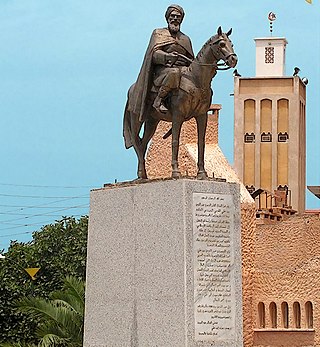
Abd al Mu'min was a prominent member of the Almohad movement. Although the Almohad movement itself was founded by Ibn Tumart, Abd al-Mu’min was the founder of the Almohad dynasty and creator of the dynasty's empire. As a leader of the Almohad movement he became the first Caliph of the Almohad Empire in 1133, after the death in 1130 of the movement's founder, Ibn Tumart, and ruled until his death in 1163. Abd al-Mu'min put his predecessor's doctrine of Almohadism into practice, defeated the Almoravids in present-day Morocco, and extended his rule across Al-Andalus and as far as Tunis in Ifriqiya, thus bringing the Maghreb in North Africa and Al-Andalus in Europe under one creed and one government.

São Brás de Alportel is a town and municipality in the District of Faro, Algarve region, in Portugal. The population in 2011 was 10,662, in an area of 153.37 km². The present Mayor is Vítor Guerreiro, elected by the Socialist Party. The municipal holiday is June 1.
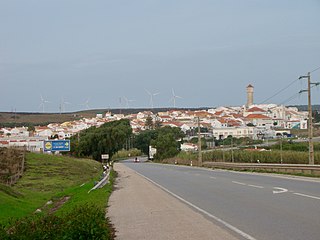
Vila do Bispo is a municipality (concelho) in the Portuguese Algarve. It has 5,717 inhabitants in an area of 179.06 km2.

Arrifana is a small parish and fishing village in the Faro District's Aljezur Municipality in the Barlavento Algarvio region of Portugal. It is situated near the border between the Aljezur and Alentejo regions on the coast of the Atlantic Ocean and is within the Costa Vicentina park. Arrifana is located about 6 km from Aljezur.

The Prehistoric Rock-Art Site of Escoural Cave is a structure known for its Paleolithic-era rock-art and funerary burial site, located in the Portuguese municipality of Montemor-o-Novo, in the civil parish of Santiago do Escoural.
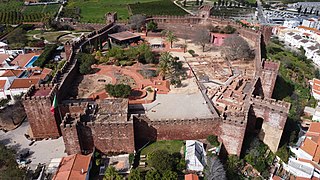
The Castle of Silves is a castle in the civil parish of Silves in the municipality of Silves in the Portuguese Algarve. It's believed that the first fortifications were built upon a possible Lusitanian castro, by the Romans or Visigoths. Between the 8th and 13th centuries, the castle was occupied by the moors who expanded it, making it one of the best preserved Moorish fortifications in Portugal, resulting in its classification as a National Monument in 1910.

The Castle of Aljezur is a medieval castle founded in the parish of Aljezur, in the municipality of the same name overlooking the Aljezur River. Excavations in the castle have discovered that the location was occupied during the Bronze and Iron Ages, while the parade grounds, habitational structures, and two silos date to the 12th and 13th centuries.
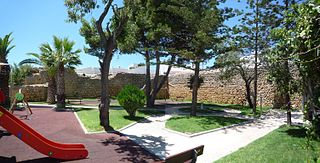
The Castle of Alvor is a medieval castle in the civil parish of Alvor, in the Portuguese district of Faro: considered to be a significant military monument associated with the nearby Castle of Silves.

Aljezur is a town and municipality of the District of Faro and Algarve region, in Portugal. The population in 2011 was 5,884, in an area of 323.50 km². The municipality comprises 4 parishes.
Castle of Cola is an Iron Age residence and Islamic redoubt in the Portuguese Alentejo, classified as a National Monument. The castro is part of a larger archaeological park of Castro da Cola, that includes various Megalithic and Calcolithic monuments, including necropolises of the Bronze and Iron Ages. The Castro-era polygonal plan, included reinforced blocks, with an entrance controlled by tower. The remaining defensive structure was circled by walls, with still exist, on the neighboring pasture-lands protecting the castle.

Praia do monte Clérigo is a beach within the municipality of Aljezur, in Algarve, Portugal. The beach is on the western Seaboard in the north west of the Algarve. The beach is 5.1 miles (8.2 km) north west of the village of Aljezur, and is 70.0 miles (112.7 km) north west, by road, from the regions capital of Faro. Praia do monte Clérigohas been designated a blue Flag beach (2012).
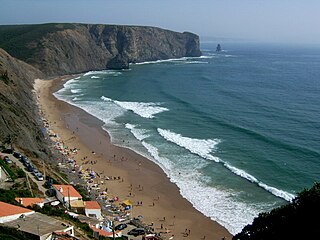
Praia da Arrifana is a beach within the Municipality of Aljezur, in the Algarve, Portugal. The beach is on the western Seaboard in the north west of the Algarve. The beach is 6.0 miles (9.7 km) south south west of the village of Aljezur, and is 71.0 miles (114.3 km) north west, by road, from the regions capital of Faro. The beach of Praia da Arrifana is inside the Vicentine Coast Natural Park, an area of outstanding natural beauty. Praia da Arrifana has been designated a blue Flag beach (2012).

The Islamic Fishing Village is an archaeological site close to the town of Carrapateira in the municipality of Aljezur, Algarve Region of Portugal. The site was excavated by a team of researchers from the New University of Lisbon in 2001. This permitted the settlement to be dated to the 12th and 13th centuries, during the Almohad Caliphate at the end of the Muslim occupation of the Algarve.
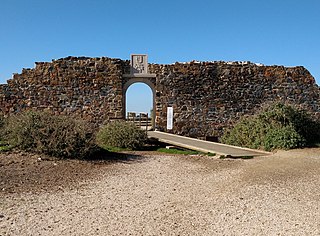
The Fort of Arrifana, or Fortress of Arrifana, ) is situated on the Vicentine Coast of the Algarve region of Portugal, on a promontory close to the town of Aljezur. It was originally constructed in 1635 with the intention of protecting fishing grounds for tuna as well as defending the coast. Its location provides a natural lookout over Arrifana Beach and the Vicentine Coast.

The Fort of Almádena or, also known as the Fort of the River Mouth, is located between the towns of Salema and Burgau, in the Algarve region of Portugal. It was constructed in 1632. Damaged by the 1755 earthquake, it was abandoned in 1849.

Fort São Vicente is a military monument in Sagres, in the Algarve region of Portugal. It consists of the remains of a fortification, with a lighthouse inside. It was built in the 16th century to protect a coastal strip and an existing monastery on the site. In 1587 it was destroyed by British privateer Francis Drake, and rebuilt in 1606. In the mid-19th century, a lighthouse was built on the site, which was replaced by a new one in the early 20th century. In the mid-2000s, Cape São Vicente was closed to the public for construction work.



















